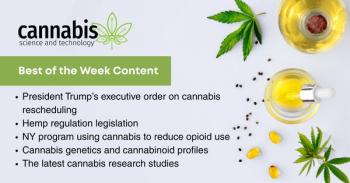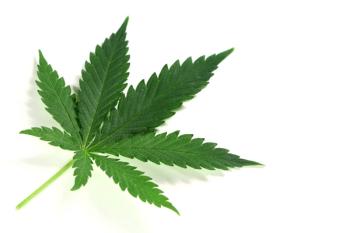
Medical Cannabis for Analgesia: Growth and Development
A review of the literature to examine the analgesic properties of cannabis.
Pain, by definition, is described as mental or physical suffering. Different receptors register different events and essentially convey to the brain if the experience is to be deemed painful or not. The peripheral nerves run throughout your body and send signals from nerve endings to the central nervous systems to register pain as well as other sensations. In addition to registering pain, the peripheral nerves also have been shown to have cannabinoid receptor type 1 and cannabinoid receptor type 2; both found to be to vital in analgesia. This article reviews the literature to examine the analgesic properties of cannabis. In the first section we focus on studies and recorded observations on medicinal cannabis for pain relief mainly based in the 19th century. As the second and third sections unfold, we transition to more recent studies up until the 21st century, as well as what direction we are currently headed in. We close out by discussing the way cannabinoids alleviate pain by binding to the peripheral and central nerves based on current studies.
When we think of cannabis many conflicting thoughts tend to come to mind, such as it’s an illicit drug and yet has been used in the medical field since its discovery. From movies such as Reefer Madness to being labeled as a “gateway drug,” cannabis has gained a negative connotation over the years despite its many health benefits. The first case of cannabis being used in a pharmaceutical manner can be traced back to 2737 B.C. when Chinese emperor Shen Neng began to prescribe cannabis to treat illnesses such as gout, beriberi, and rheumatism. If we fast forward to the 21st century and examine studies, we will see that cannabidiol (CBD) oil has been studied for its benefits in treating rheumatoid arthritis. There have been many writings on cannabis in general found in the B.C. era in China. Though it is not mentioned in abundance, there is evidence that early Chinese cultures used cannabis for medicinal purposes, but they did in fact know about its psychotropic properties. It has been noted (1) that if used for a prolonged time, cannabis would produce different hallucinogenic effects but, with the decline in shamanism in the Han Dynasty, the use of cannabis as a hallucinogen fell out of practice. Many cultures spoke of using cannabis in a lot of different medicinal forms whether it was the Assyrians using it as a cure for swelling and bruises or the Greeks using “juice” from the cannabis seeds as a cure for earaches (2).
As time progressed, there was never a clear decrease in cannabis use in medicinal purposes. By the start of the 19th century there was a sharp rise in studies on the medicinal benefits of cannabis, especially in western civilization. In 1843, William Brooke O’Shaughnessy introduced his findings from India detailing how different cannabis tinctures were made in India as well as the effects these tinctures had on each patient (3).
Medicinal Cannabis in the 19th Century
O’Shaughnessy begins with his description of tests run on animals in the beginning; the first of which being done on a medium sized dog. In this early cohort study, O’Shaughnessy was simply observing the effects of a tincture made of 10 grains of ”Nipalese churrus” dissolved in a spirit (3). The effects of the tincture were described as giving the dog a “stupid” state followed by hunger and a long slumber; throughout the whole ordeal the dog was described as very content. Similar reactions were found as tests were continued on dogs. Deeper into O’Shaughnessy’s article he gives examples of patients whom had acute rheumatism; all of whom had not been responding to conventional methods of treatment. Though one patient had adverse effects where they fell into a catalepsy state; all patients with the exception of the habitual cannabis user stated loss of pain associated with the acute rheumatism. One patient even described himself as ”being in perfect health” after taking one grain of resin; while one of the other patients exclaimed he was free of all symptoms after taking the tincture and having a full night’s rest. O’Shaughnessy was able to observe several more cases in which the half-grain dose of cannabis resin was used as treatment in acute and chronic rheumatism; across the board it was shown that the resin was able to attenuate the pain.
In 1845 Mr. M. Donovan began to do his own experimentation of Indian cannabis, which was the main source for O’Shaughnessy’s experiments. Donovan’s interest in the subject matter stemmed from his own suffering of neuralgic pain (4). In his early attempts, Donovan found no effects after making his own resin and tincture by using Indian hemp that he obtained from various sources. He deemed the reason for his tincture and resin not being as potent as O’Shaughnessy’s because of poor cultivation techniques as well as the possibility that the cannabis loses its potency after being cut and thus has a finite time in which it can be used and still produce the desired effects. This issue was eradicated by obtaining fresh resin samples made by O’Shaughnessy himself. During one of his pain attacks Donovan took the tincture made from O’Shaughnessy’s resin and in 20 min he described himself as having no pain whatsoever. He also described a feeling of moving around without giving thought to his legs to the point that he felt as if “they (his legs) did not belong to me” (4). It can be observed through Donovan’s account that as time went on, he had to take higher doses of tincture in order to alleviate his pain.
In an article published in The Lancet in March 1890, one man by the alias W.W. gives his own account of the adverse effect of taking a cannabis tincture. He description goes as follows (5):
“The neuralgia, was soon forgotten, and in about an hour’s time I began to feel giddy, full in the head, and very faint, and soon experienced a sensation of heaviness and numbness in the feet and legs, followed by partial anesthesia, gradually extending upwards to the knees. My feet and legs felt as if enormously swollen and thickly covered over with wool. Soon the loss of sensation became complete as far as the knees; walking was then impossible and even standing a difficulty. Shortly similar symptoms appeared in the upper extremities, commencing at the finger tips and extending as far as the elbows. The anesthesia was not so complete as in the lower extremities. During this time there was great anxiety and fear of death through cardiac paralysis, which seemed almost imminent. The heart’s action was tumultuous and irregular. On the return of sensation to the extremities, I was possessed with an almost irresistible desire to commit suicide, by rushing into the adjoining canal or cutting my throat with the knives on the table close by, though no attempt was made at doing so. Shortly upon this I was seized with fits of alternate laughter and crying, without any apparent cause.”
W.W. ended the article stating he was aware that cannabis tinctures don’t affect everybody the same way, but that he would never take it as a cure again as well as “be most careful in prescribing it to others.” In a turn of events Dr. J.R. Reynolds gave a retort to W.W.’s article seven days later. In his article, Dr. Reynolds explained why one might succumb to toxic symptoms after taking a cannabis tincture. Dr. Reynolds’ explained the symptoms related to the tincture not being made homogenous in addition to different cannabis resin being extracted from different strands grown in different regions. He concluded that to combat against this the cannabis should be obtained from the same source and users should start with the lowest possible dosage before ramping up in attempts to test the potency of the tincture made and gradually increased from there (5). Dr. Reynolds also gave a list of steps to take when taking a tincture of the pharmacopoeia and assured readers that in all his studies, when subjects followed his method for dosing, no one experienced an adverse effect.
20th Century Analgesic Properties
In the 20th century, cannabis became listed as a Schedule 1 drug and a decrease in studies on cannabis were also noted until the later part of the century. At that point, studies began to center around the concept of discerning what cannabinoids could be used to treat which ailments and how these treatments would compare to drugs already on the market.
Noyes Jr., Brunk, Avery, and Canter (6) examined the analgesic properties of tetrahydrocannabinol (THC) in comparison to codeine. In this double-blind experiment, the 36 subjects were given either a 10 mg or 20 mg tablet of THC concentrate or a 60 mg or 120 mg tablet of codeine, in addition a placebo was also used (6). Subjects were asked to rate their pain on an hourly basis after receiving one of the listed treatments, in addition to them being observed over the course of 7 h. Table I in the Noyes article (6) details how close the relief of the 60 mg of codeine was compared to the 10 mg of THC.
In another attempt to show the angelic properties of cannabis, a test in which the subjects were given a mix between aspirin, THC, and propoxyphene was done (6). These results can be seen in Table V in the Noyes article (6), where it was shown that 10 mg of THC had about the same effectiveness on pain that the 600 mg of aspirin did.
Noyes and colleagues (6) concluded that THC does indeed have analgesic properties, but more research should be done to perfect the dosages given to avoid adverse effects such as dizziness, blurred vision, nausea, and diarrhea. Those side effects were observed in patients no matter if they took the codeine, THC, or the placebo pill.
In the same year there was a study done by S.L. Milstein, K. MacCannell, G. Karr, and S. Clark to see how cannabis effected pain tolerance (7). This too was a double-blind experiment in which subjects were given 600 g of 1.3% THC marijuana and a THC-extracted marijuana seven days apart (7). Under the influence of both respectively, subjects were asked to put their thumb in a vice that would continue to add pressure until it was unbearable, at which point they would press stop and the final pressure would be recorded. To preface this experiment and make sure the subjects weren’t under the influence of anything else, subjects were asked to be sober from alcohol for at least 24 h before the experiment and sober from other drugs for at least seven days before (7). There is a graph in the literature (7) that shows both experienced cannabis users and first timers had a higher tolerance for pressure. It was also observed that after smoking the placebo marijuana the pain tolerance dropped.
Recent Studies in Medicinal Cannabis
After California legalized cannabis for medicinal use in 1996 continued experimentation increased in western parts of the world.
In 2011, it was shown that there was a 500% rise in Human Immunodeficiency Virus (HIV) cases over the recent decades (10). One of the most common peripheral nerve disorders associated with HIV is HIV-associated sensory neuropathy (SN) (8). This was the subject of a 2007 (8) study where cannabis was used to decrease the amount of pain in patients suffering from HIV-SN. In this randomized study, subjects were given either a 0.9 g cannabis cigarette containing 3.56% THC or a cannabis cigarette containing 0% THC (8). Approximately 52% of the subjects that were exposed to the cigarettes that contained THC saw a decrease in pain by up to 34%. Comparatively, only 24% of subjects that were exposed to the placebo experienced pain relief up to 17% (8). It can be seen in a figure in the literature (8) that pain levels drop immediately after the first cannabis cigarette and begin to rise once the subject smoked their last cigarette.
Many studies during this century have shown cannabis to have analgesic properties when treating a variety of diseases (8–10). Another study done in 2010 examined patients with chronic neuropathic pain from either post-traumatic or post-surgical events. These 23 patients were given cannabis with THC potencies at four different levels including 0%, 2.5%, 6%, and 9.4% (10). It can be seen from their results that pain registered significantly lower when using cannabis at a level of 9.4% THC versus 0% when measured on an 11-point numeric rating scale (10). The patients that received the 9.4% THC cannabis also reported sleeping better as well as having lower anxiety levels, while simultaneously having no effect on patient’s mood or quality of life (10).
Repeatability is one of the steps to having a method validated. If we look at cannabis as a method for treating pain, throughout history it has had very repeatable results with minor adverse effects. Even still, cannabis is labeled as a Schedule 1 drug with no medical benefits (11). In one of the more recent studies done in 2018, we see the examination of the withdrawal symptoms commonly associated and observed with medical patients who use cannabis for their chronic pain issues. In this article, they list the most common withdrawal factors as sleep difficulties, anxiety, irritability, and appetite disturbance (12). Some of the limitations noted in this article included the fact that they were unable to distinguish the differences in withdrawal symptoms and functioning; they also stated the participants were more than likely not in withdrawal state at the time of the study (10). In all though, we see that the common theme is more research is needed. This is a fact that can’t be denied, the scientific community is constantly changing. As time goes on, we are getting better in not only testing methodology but becoming more stringent on testing products to ensure safety. We can look at California as an example when it comes to testing regulations to ensure no mycotoxins, heavy metals, or pesticides are being produced in cannabis and cannabis products, all regulated by the Bureau of Cannabis Control (BCC) (13).
Cannabinoid Binding
The antinociceptive and analgesic effects of activated cannabinoid receptor type 1 (CB1) and cannabinoid receptor type 2 (CB2) receptors have been proven in a plethora of studies since the late 1990s (14–16). It was found in a 1980 study that CBD does in fact have antagonist properties (17). During this study, monkeys were given doses of THC, CBD, and a THC:CBD mixture. It was observed that when combined with CBD, THC’s behavioral effects diminished (17). In a 2002 study it was found that CB2 receptors were able to act as an anti-inflammatory as well as offering an analgesic effect when activated on its own (18). It was also deemed that the adverse effects are a result of THC binding to CB1 receptors because of the fact that they have distribution outlets within the central nervous system, where psychoactivity takes place; these effects weren’t observed when CB2 receptors were activated on their own which only are found on the peripheral nerves (18). From this one study, we can see why a drug with a high CBD content would be able to decrease the chances of having any adverse effect (19). While CBD antagonist properties are shown to modulate, in a sense, the THC binding to CB1 receptors within the central nervous system, it has also been shown that the agonistic properties of THC are essential in blocking the glutamate release within the glutamatergic system, which in turn helps to reduce hyperalgesia from migraines (20,21). This is because of THC being able to reduce the N-methyl-D-aspartate receptor (NMDA) responses by 30–40% (20,21).
When it comes to cannabis and pain relief, the agonist or antagonist behavior exhibited by the cannabinoid in relation to the CB1 or CB2 receptor is important to examine. Taking this a step further and examining the properties of CBD and THC, both have analgesic properties on neuropathic pain. Different cannabinoids with agonist, antagonist, or inverse agonist properties are classified contingent on their unique chemical structure (22). It was found in a 2004 study that CBD antagonism can also help to reduce addictive potential and tolerance levels (23), thus a patient would need higher dosage as treatment progressed. In 2006 it was shown that CBD combats the adverse effects THC causes in the central nervous system by suppressing the oxidation of Δ9-THC to 11-Hydroxy-THC, which has high psychoactive properties (24).
Conclusion: What’s on the Horizon
As time progresses, more benefits of cannabis when it comes to analgesia are being recognized. In the United States, the first U.S. Food and Drug Administration (FDA) approved cannabis-based medicine, Epidiolex, was approved in June 2018. This is different from the FDA-approval of Marinol simply because it uses CBD extracted from actual plants versus using a synthetic cannabinoid. In 2010, the approval of Sativex (trade name) in the UK was a ground-breaking move in the field of pharmaceutical cannabis because of its composition of a 1:1 ratio of THC:CBD. The effectiveness of Sativex was found through clinical trials in which 74.6% of patients found relief from multiple sclerosis spasticity in the first month of taking the drug (25). These two drugs alone are signs that times are changing, and the country is moving into the realm where medicinal cannabis may be available everywhere. By continuing to study the effects of the more than 100 cannabinoids found in cannabis it’s possible to derive a concentration in which we have the analgesic properties sought after without the adverse effects that are commonly associated.
Acknowledgements
The authors would like to acknowledge Jesus Medina and Sean Fernandez for their continued support in the preparation of this manuscript. JB gathered the information. JB and NA reviewed and edited this manuscript. Both authors have read and approved the final manuscript.
References
- M. Touwn, J. Psychoactive Drugs.13(1), 23–34 (1981).
- A.W. Zuardi, Brazilian Journal of Psychiatry28(2), 153–157, doi:10.1590/s1516-44462006000200015 (2006).
- W.B. O’Shaughnessy, Provisional Medical Journal Feb. 4, 1843, 336–339.
- M. Donovan, The Dublin Journal of Medical Science26(3), 368–402, doi:10.1007/bf02971741 (1845).
- W.W., The Lancet 135(3472), 621, doi:10.1016/s0140-6736(02)15560-7 (1890).
- R. Noyes, F.S. Brunk, D.H. Avery, and A. Canter, Clin. Pharmacol. Ther.18(1), 84–89, doi:10.1002/cpt197518184 (1975).
- S. Milstein, K. MacCannell, G. Karr, and S. Clark, Int. Pharmacopsychiatry10(3), 177–182, doi:10.1159/000468188 (1975).
- D.I. Abrams, C.A. Jay, S.B. Shade, H. Vizoso, H. Reda, S. Press, and K.L. Petersen, Neurology68(7), 515–521, doi: 10.1212/01.wnl.0000253187.66183.9c (2007).
- M.A. Ware, C.R. Doyle, R. Woods, M.E. Lynch, and A.J. Clark, Pain102(1), 211–216, doi:10.1016/s0304-3959(02)00400-1 (2003).
- M.A. Ware, T. Wang, S. Shapiro, A. Robinson, T. Ducruet, T. Huynh, and J. Collet, Can. Med. Assoc. J.182(14), doi:10.1503/cmaj.091414 (2010).
- Controlled Substances (PDF). (2018, October 01). Drug Enforcement Agency.
- B.E. Perron, K.R. Holt, E. Yeagley, and M. Ilgen, Drug Alcohol Depend.194, 401–409, doi: 10.1016/j.drugalcdep.2018.09.029 (2018).
- United States, Bureau of Cannabis Control, State of California. (2018, June). Bureau of Cannabis Control Text of Regulations. Retrieved from
https://bcc.ca.gov/law_regs/readopt_text_final.pdf . - A. Calignano, G.L. Rana, A. Giuffrida, and D. Piomelli, Nature394(6690), 277–281, doi:10.1038/28393 (1998).
- A. Hama and J. Sagen, Brain Research1412, 44–54, doi:10.1016/j.brainres.2011.07.031 (2011).
- J.D. Richardson, S. Kilo, and K.M. Hargreaves, Pain75(1), 111–119, doi:10.1016/s0304-3959(97)00213-3 (1998).
- K.T. Brady and R.L. Balster, Psychopharmacology72(1), 21–26, doi:10.1007/bf00433803 (1980).
- N. Clayton, F.H. Marshall, C. Bountra, and C.T. O’Shaughnessy, Pain96(3), 253–260, doi:10.1016/s0304-3959(01)00454-7 (2002).
- R. Mechoulam and L. Parker, Br. J. Pharmacol.170(7), 1363–1364, doi:10.1111/bph.12400 (2013).
- E. Russo, Therapeutics and Clinical Risk Management 4, 245–259, doi:10.2147/tcrm.s1928 (2008).
- E.J. Rahn, A. Makriyannis, and A.G. Hohmann, Br. J. Pharmacol.152(5), 765–777, doi:10.1038/sj.bjp.0707333 (2007).
- G. Muccioli and D. Lambert, Curr. Med. Chem.12(12), 1361–1394, doi:10.2174/0929867054020891 (2005).
- J.D. Vry, K.R. Jentzsch, E. Kuhl, and G. Eckel, Behav. Pharmacol. 15(1), 1–12, doi:10.1097/00008877-200402000-00001 (2004).
- E. Russo and G.W. Guy, Med. Hypotheses 66(2), 234–246, doi:10.1016/j.mehy.2005.08.026 (2006).
- P. Flachenecker, T. Henze, and U.K. Zettl, Eur. Neurol.71(5–6), 271–279, doi:10.1159/000357427 (2014).
Jamal Bouie is a cannabis chemical analyst based out of Long Beach, California. He is a member of the Long Beach Collective Association (LBCA) as well as the SoCal Cannabis Science Research Group (ScCSRG). Niranjan Aryal is a lab director for a cannabis testing laboratory in the SoCal area. He is also a member of the SoCal Cannabis Group and is continuously looking for ways to complete research within the cannabis field. Direct correspondence to:
How to Cite This Article
J. Bouie and N. Aryal, Cannabis Science and Technology 2(5), 62–65 (2019).
Disclosures:
This article was originally published by Cannabis Science and Technology in October 2019. The original story can be found here:
Newsletter
Unlock the latest breakthroughs in cannabis science—subscribe now to get expert insights, research, and industry updates delivered to your inbox.




